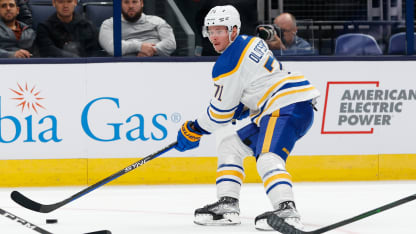Olofsson confident Sabres can carry over late success last season
Forward believes 'mentality changed' during 16-9-3 run to end 2021-22

"We found a way to just go out and enjoy it and play some really good hockey," Olofsson said. "When we're at our best is when we don't think too much, we just go out and play and have fun. You've got to do that for a full season.
"Like the team, my biggest problem has been staying on a high level for 82 games."
The Sabres were able to play at a high level for the final 28 games of last season, with the forward playing a big role.
Buffalo went 16-9-3 in that span after winning 16 of its first 54 (16-30-8). Olofsson had 25 points (13 goals, 12 assists) and was plus-6 in those final 28 games. He had 24 points (seven goals, 17 assists) in playing 44 of the first 54 games.
RELATED: [Buffalo Sabres 2022-23 season preview]
Olofsson, speaking during the NHL European Player Media Tour in August, said the Sabres played those final games relaxed instead of tense, that they didn't let the pressure of a loss carry into the next game. He talked about how they were better with consistency and not allowing setbacks to linger.
"Big step," he said. "I feel like the mentality changed. We played some really good hockey and competed against some of the best teams. If we can a find a way to get to that level right from the beginning of the season and find a way to be at that level we'll be a good team."
The Sabres have struggled to stay on a high level for 11 straight seasons, the longest active streak in the NHL without reaching the Stanley Cup Playoffs.
Olofsson has too the past three seasons.
He had 42 points (20 goals, 22 assists) in 54 games as a rookie in 2019-20, but dipped to 32 points (13 goals, 19 assists) in 56 games in 2020-21.
He started fast last season with nine points (five goals, four assists) in eight games in October but hurt his wrist Oct. 31, an injury that kept him out eight games and hampered his ability to shoot when he came back Nov. 21.
Olofsson scored a goal in the game he injured his wrist, then didn't score another one until Feb. 15, a streak of 30 games without one.
"It was frustrating," he said. "I started overthinking. It's a long season and injuries are going to happen. I think I really learned from that last year."
Olofsson, like the Sabres, is prepared to carry those lessons into this season and hopes to pick up where he left off.
He signed a two-year, $9.5 million contract ($4.75 million average annual value) on July 13 and the Sabres see the 27-year-old as a key part of their forward group, a player who can bridge the gap between NHL veterans such as Jeff Skinner, 30, and Kyle Okposo, 34, and up-and coming players, including Dylan Cozens, 21; Peyton Krebs, 21; Jack Quinn, 21; and JJ Peterka, 20.
"He's still a younger player but now he's that next tier where he's been in the League a little while, he's got experience, but he's still right in his prime," general manager Kevyn Adams said. "You look at some of our younger guys, these are really talented players but they are just starting, just finding their way, whereas Victor has more experience. We feel that Victor is going to be consistent one game to the next game. We know the team that we have and it's nice to have that in your lineup every night."
The optimism about Olofsson's future is built as much on his production in the second half last season as it is the overall balanced game he showcased.
"He missed scoring primarily because he couldn't shoot, so he had to figure out, 'How can I focus on other things because I can't play the game I want to play right now even though I have a uniform on and I'm in the lineup,'" Sabres coach Don Granato said. "He, I don't want to say reinvented himself, but he was forced to think about things differently and he found a way to become successful doing things differently."
Like being more engaged physically.
"His production came back, but he was also 5-on-5 competing really hard at the end of the year, playing on the inside more and really battling for 50/50 pucks, winning his wall battles," Adams said. "A lot of his career you could see the talent, his shot, the power-play production, but it looked like he really took a step."
Olofsson's teammates took notice.
"He has been better finding his way to the net and being greasier and a little bit more dirty," defenseman Rasmus Dahlin said. "So he's not just a power-play guy anymore. He's a really good hockey player."
A potentially sneaky good one on a team that could have as many as nine forwards around him who were first-round picks in the NHL Draft.
Buffalo selected Olofsson in the seventh round (No. 181) of the 2014 NHL Draft.
"He's a big part of our atmosphere behind the scenes and he's obviously a dangerous player within our lineup that can strike at any moment," Granato said. "We've seen him look like he's in the background and the other team doesn't have to pay attention to him and they get a false sense of security in moments. He has the ability to just slip in there when you're not paying attention to him."
NHL.com staff writer Amalie Benjamin and NHL.com independent correspondent Heather Engel contributed to this report

















